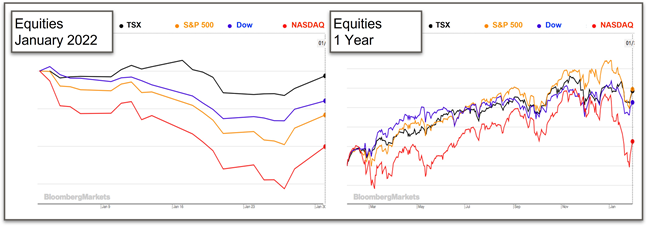What happened in January?
At the beginning of the month, equities fell during the first week, regained their value and stabilized before dipping strongly around the end of week 3, and ended the month regaining some lost value. Overall equities performed poorly for several reasons.
The central banks for the two largest and developed economies in North America announced monetary policy updates on the last Wednesday of the month, January 26th. The Federal Reserve and the Bank of Canada held their benchmark rates unchanged and are now poised to increase interest rates in March.
Intra and inter-day volatility rose as the comments made by Fed Chair, Jerome Powell, were released. He indicated that rates could be increased without harming employment. It appears that the Fed may increase rates rapidly before slowing the number of increases as 2022 proceeds. All of the maneuvering by the Fed is to control inflation which is well above the 2% goal, sitting at 7% as of December. The Fed also plans to end its bond-buying program in March and to reduce its holdings that support long-term interest rate reduction. Fed Press Release
The Bank of Canada had already ended its bond-buying support last autumn. Interest rates were left unchanged due to uncertainty of the negative effects of Omicron and inflation at approximately half the U.S. rate. BoC Press Release
The past month did not deliver the results that equity investors desire with the major indices and every indicator in our grid falling in value, except for oil. North American equity indices fell about 1 to 9% the global All Country World Index (ACWI) that includes 25 Emerging Markets fell 5% in January.
In addition to the price changes (i.e. drops) for equities, volatility rose as January progressed as speculation about interest rates increases rose and the political situation in the Ukraine continued. Generally, the higher the volatility the bigger the price changes can be in the short-term. Volatility Definition The VIX volatility index reached its highest level since early 2021 as analysts digested central bank guidance for their stand-pat policies and tensions between NATO and Russia rose. Volatility Index
The latest variant of concern, Omicron, which has been spreading rapidly in southern Africa, caused widespread concern globally. Travel restrictions have been reintroduced in several developed nations preventing foreign citizens entry when arriving from eight African countries. https://www.cbc.ca/player/play/1978247747665
The U.S. economy added 199,000 jobs in December with year-over-year wages rising 4.7% and unemployment at 3.9%. Analysts expected about 400,000 new jobs to be created last month and 3.6 million less jobs exist at year-end than in February 2020. The Canadian economy bested jobs growth expectations during the last two months. After adding 153,000 jobs in November and 55,000 in December, the rate of employment growth is exceeding the U.S. while Canadian wage increases and unemployment rates lag behind the American economy’s performance. https://www150.statcan.gc.ca/n1/daily-quotidien/220107/dq220107a-eng.htm?HPA=1 https://www.bls.gov/news.release/empsit.nr0.htm
The big economic news from last month was the release of the latest Consumer Price Index (CPI) data in the U.S. Year-over-Year prices have risen 7.0%, the highest inflation reading since 1982, 39 years ago. Energy (fuel, fuel oil, natural gas) and used vehicle prices have risen the most at 29.3% and 37.3%, respectively. Groceries (food at home) nearly matched the overall rate after rising 6.5% since last December. Removing energy and food, two categories that can deliver volatile price changes, inflation for Goods has risen nearly 11%, which is also the largest increase since 1982. Services (less energy services) have risen a relatively modest 3.7%, still far above the goal of 2% average total inflation. https://www.bls.gov/news.release/cpi.nr0.htm
The latest variant of concern, Omicron, which has been spreading rapidly in southern Africa, caused widespread concern globally. Travel restrictions have been reintroduced in several developed nations preventing foreign citizens entry when arriving from eight African countries. https://www.cbc.ca/player/play/1978247747665
The U.S. economy added 199,000 jobs in December with year-over-year wages rising 4.7% and unemployment at 3.9%. Analysts expected about 400,000 new jobs to be created last month and 3.6 million less jobs exist at year-end than in February 2020. The Canadian economy bested jobs growth expectations during the last two months. After adding 153,000 jobs in November and 55,000 in December, the rate of employment growth is exceeding the U.S. while Canadian wage increases and unemployment rates lag behind the American economy’s performance. https://www150.statcan.gc.ca/n1/daily-quotidien/220107/dq220107a-eng.htm?HPA=1 https://www.bls.gov/news.release/empsit.nr0.htm
The big economic news from last month was the release of the latest Consumer Price Index (CPI) data in the U.S. Year-over-Year prices have risen 7.0%, the highest inflation reading since 1982, 39 years ago. Energy (fuel, fuel oil, natural gas) and used vehicle prices have risen the most at 29.3% and 37.3%, respectively. Groceries (food at home) nearly matched the overall rate after rising 6.5% since last December. Removing energy and food, two categories that can deliver volatile price changes, inflation for Goods has risen nearly 11%, which is also the largest increase since 1982. Services (less energy services) have risen a relatively modest 3.7%, still far above the goal of 2% average total inflation. https://www.bls.gov/news.release/cpi.nr0.htm
What’s ahead for February and beyond?
In addition to the growing danger of the Omicron variant and any that follow and the unstable geopolitical drama between NATO and Russia in the Ukraine, inflation remains a significant concern. The persistence, the breadth and the size of price increases are pushing central banks across the globe to act sooner than originally believed.
Expect monetary policy announcements, which will incorporate pandemic, political and economic developments, to guide the value of stocks, indices and portfolios for most of 2022.


